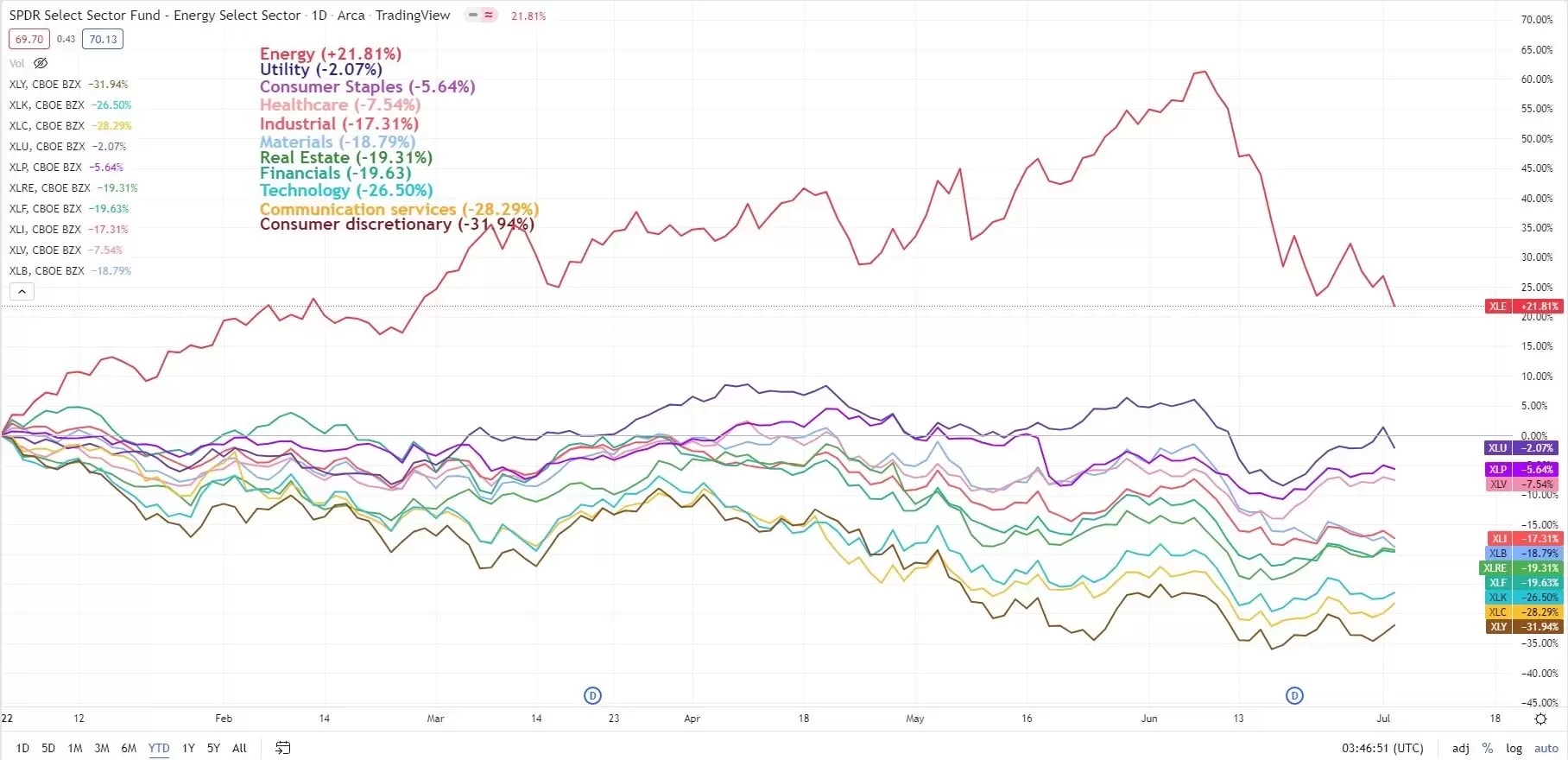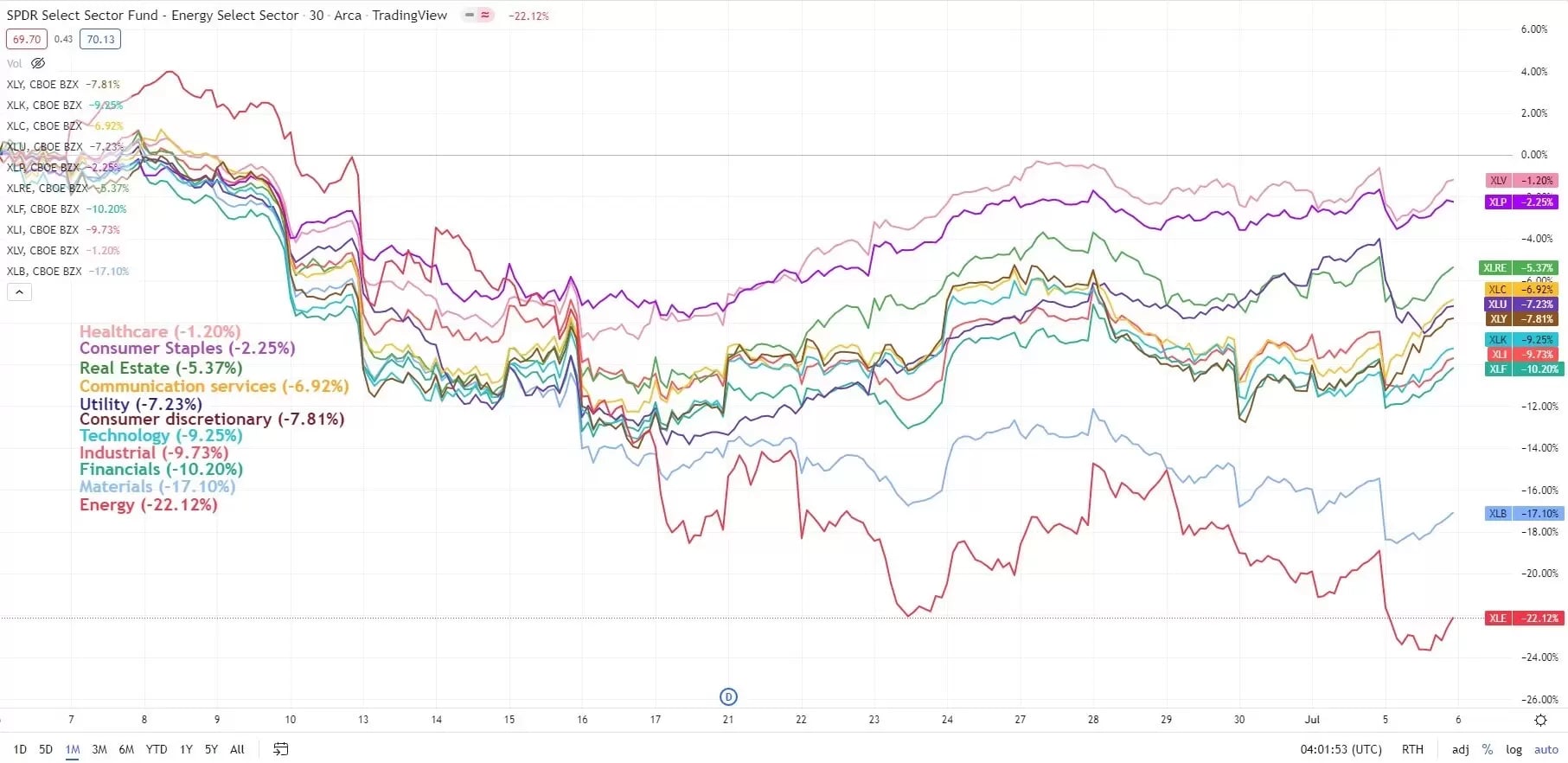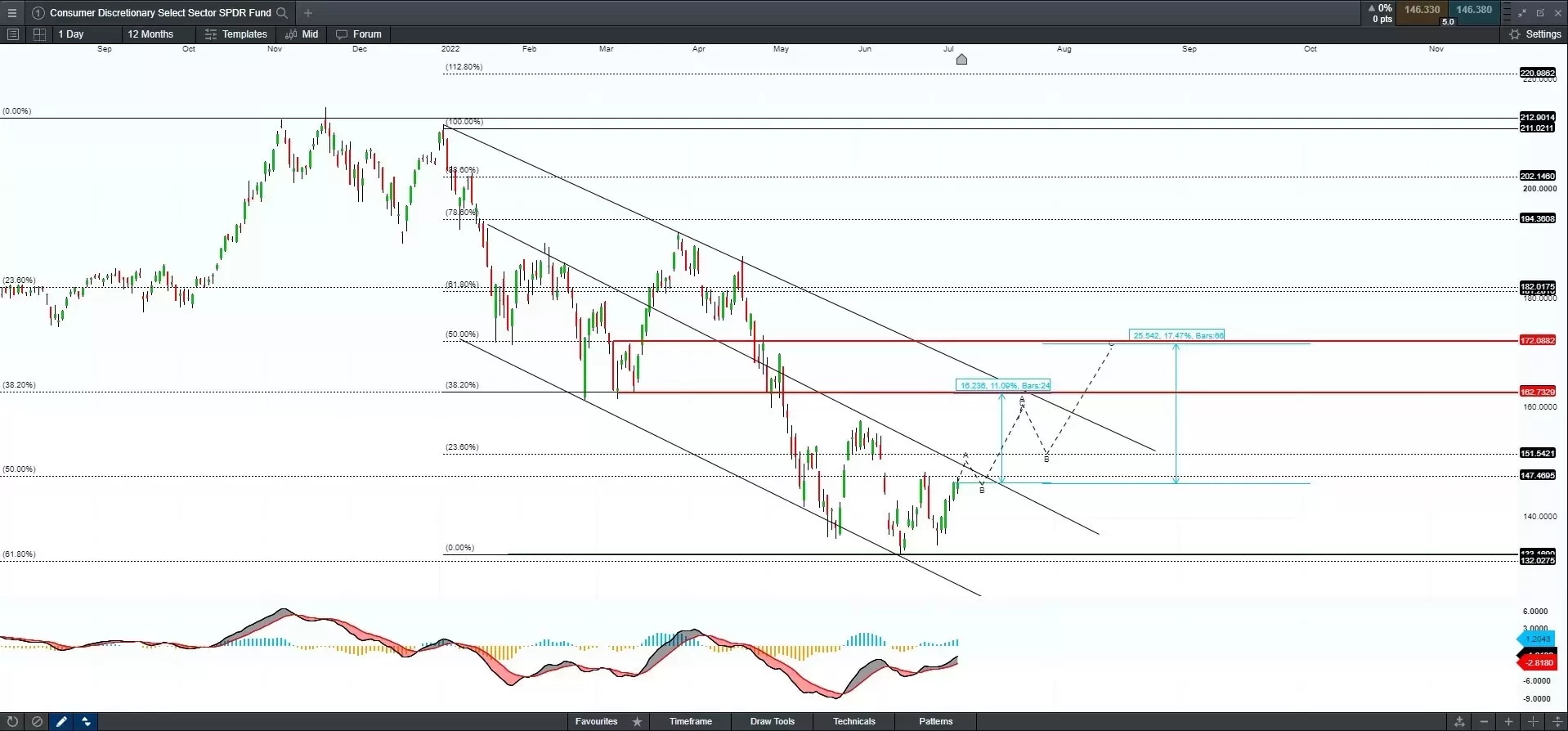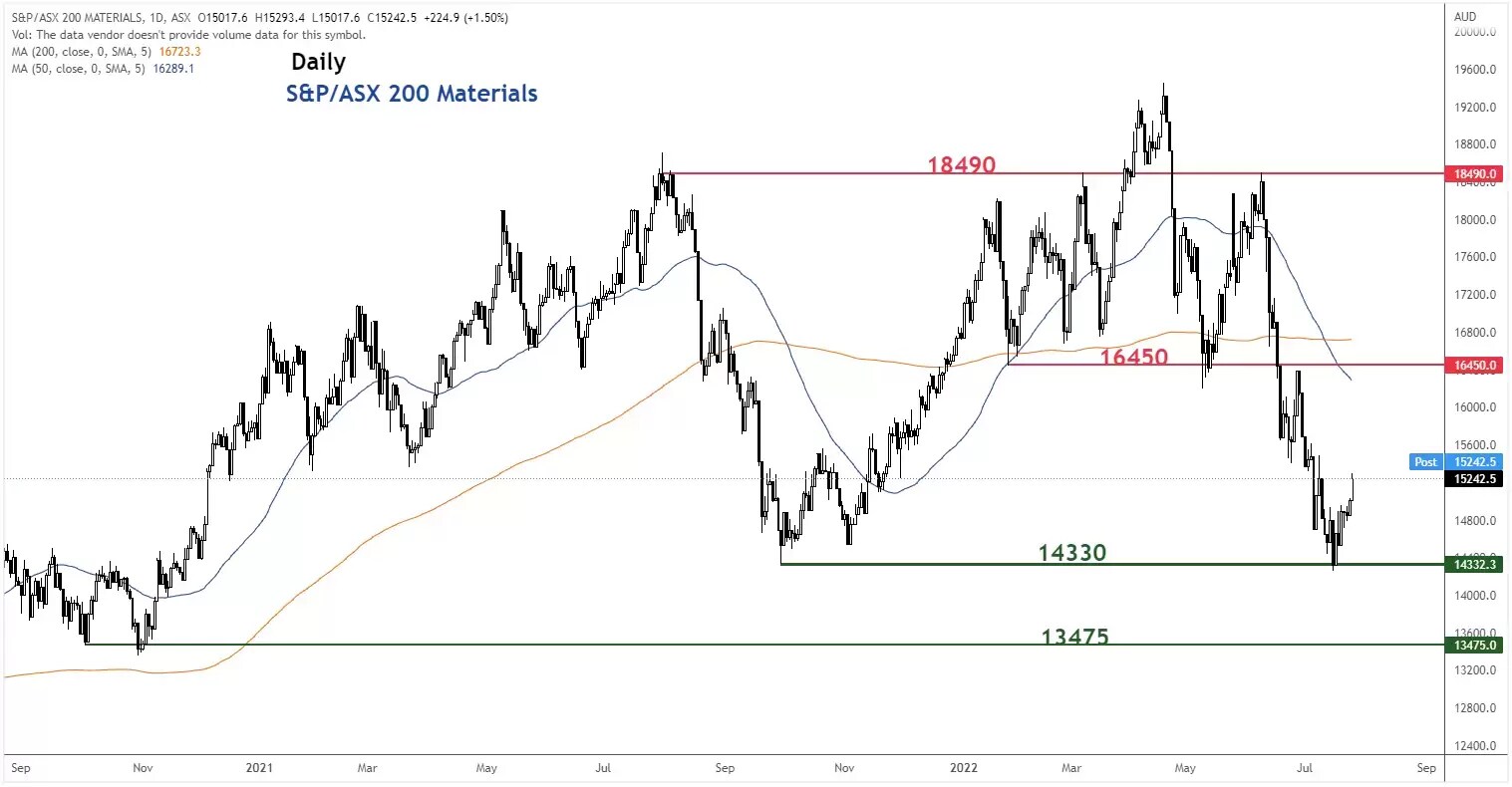This article is written by CMC APAC market analysts; Kelvin Wong, Tina Teng, Azeem Sheriff & Leon Li
US equities growth sectors may start to shine in Q3
The US economy may have entered a technical recession, with a negative growth of -1.6% in the first quarter and a projected consecutive contraction in the second quarter, though it will take time to confirm the Q2 GDP figure. As mentioned above, rapidly rising interest rates and sticky inflation have substantially softened consumer demands, leading to a downturn in inflation expectations.
As companies start laying off workers, coupled with a slow hiring and a rising unemployment environment that in turn increases the odds of looming stagflation. The US economy will certainly fall into an economic recession, with the Federal Reserve Bank playing a key role in accelerating it happen.
As the bets for a “Fed pause” on its current aggressive interest rate hiking cycle are growing based on the previously discussed “peaking inflation scenario”, we will now apply a sector rotation analysis on the S&P 500 (SPX); a proxy for the US stock market to determine which are the potential outperformers and underperformers.
SPX 11 sectors’ performances year-to-date

SPX 11 sectors’ performances for the last three months

SPX 11 sectors’ performance for the last month

Momentum ranking of the SPX 11 sectors

Source: TradingView as of 5 Jul 2022
A “Fed pause” after July may provide a broad relief rally in the US stock market, which makes the upcoming July FOMC meeting a crucial one to watch for investors to scrutinize for any hints or guidance on such a pause. In terms of the sector rotation of investment funds, the growth sectors such as communication services, consumer discretionary, and technology may outperform supported by policy tailwind, followed by the defensive sectors such as healthcare, consumer staples, and utilities. The financial stocks may also rebound in anticipation of a lower cost of funding environment in the event of a “Fed pause” scenario. However, energy and materials stocks may continue to suffer and underperform due to an anticipated recession that drums up the demand destruction narrative.
SPDR Consumer Discretionary Select Sector Fund – XLY, Daily

Source: CMC Markets as of 8 Jul 2022
Considering the consumer discretionary sector (XLY) is the worst performer year-to-date (-32%), it may rebound the most reinforced by the policy tailwind from the potential “Fed pause” scenario. From the above chart, XLY may first put a pause to its major downtrend phase for a potential push-up to test descending trendline resistance at about 163 which translates to a +11% rebound based on the current price level at this time of the writing. A break above 163 may put its major downtrend phase in jeopardy for a further potential rally towards the next resistance at 172 which is the 50.00% Fibonacci retracement of the major downtrend; a rebound of +17% from the current price level.
On the flip side, a break below the 132 pivotal support may send the XLY lower to test the next further support at 110.
ASX 200 – To bank or not to bank & is China digging a hole for Australian miners?
With the world still in chaos, China slowly coming out of lockdown, the EU squeezing Russia with commodity-imposed sanctions, and inflation still very high in developed economies, Central banks are now dominating the scene with their very aggressive and unexpected rate hikes which continue to stimulate fears of a global recession, in turn deteriorating global equity markets including the ASX.
The S&P/ASX 200 ended the quarter lower by -12.4% (6,570) by EOFY which placed it in a correction phase. This quarter included its largest monthly decline since March ’20 (-21.2%) when COVID knocked out the financial markets. It’s also the first 3 straight monthly losses since September 2018, which goes to show how infrequently these situations occur.
To summarise the 11 sectors’ performance for the last quarter, the following table/heatmap highlights the gainers and laggards (in that order).

Energy & Utilities sectors just scraped through in the green and kept their head above water, with more focus on the Energy sector due to the highly volatile commodity prices that soared during the quarter as a result of geopolitical tensions arising from the Russia/Ukraine war. Oil/Nat Gas became supply-driven commodities with the EU proposing sanctions on Russia (one of the world’s largest suppliers of oil), which meant the OPEC needed to readjust their oil reserves output to account for that gap in supply. This enabled Brent Oil to spike to $138 USD/b at the peak of the war in March which sent global fuel prices into chaos. However, the more recent fears of a global recession have flipped the narrative into demand-driven, with Brent now sitting at $98 USD/b (as of writing) and expecting to go lower.
On the other end of the spectrum, we saw the Real Estate (RE) and Info Tech (IT) sectors hit the ground hard with both dropping by -18.9% & -27.3% respectively. By definition, when interest rates rise, these two sectors tend to be the most sensitive as a large portion of their operational borrowings/funding is heavily relied on credit. So it’s not a surprise that they were the most affected during Q2 when the RBA began its quantitative tightening cycle with a 25bps hike in May, followed by a whopping 50bps hike in June & July.
Financials Sector (XFJ) – Accounts for almost 26% of the ASX

Source: TradingView as of 26 Jul 2022
Q2 saw quite a significant decline of -15.1% in the Financials sector which is heavily weighted by the major banks. The largest drop occurred in June (-11.9%) on the back of recession fears but more particularly around the potential increase of credit defaults/bankruptcies due to the aggressive quantitative tightening implemented by the Reserve Bank of Australia (RBA).
The price of money is a critical part of the economic cycle. Short & long-term debt drives the economic cycle of expansion and contraction, and we’re currently in a stage of upcoming contraction after a significant period of expansion from record low-interest rates stimulating the credit economy. This shift in credit demand from borrowers and the available credit supply reflects the changing requirements of consumers/businesses from a high savings environment to a consumption environment. Consumers have saved more than $200b and will now chew into these savings to service their upcoming debts until they rebalance their discretionary spending habits to accommodate for the high inflationary environment.
As a result, consumers/businesses may face serviceability issues, especially those with recently acquired high levels of debt, or for those entering the credit market for the first time, where prices of goods/services have been very high, particularly those in the housing market. This in turn increases the potential for bad debt, which banks have to provision for in their balance sheet. Therefore, we saw a significant drop in the banks’ share price over Q2 with major investors shorting stocks in anticipation of this, despite a positive earnings report in April.
Materials/Mining Sector (XMJ) - Accounts for almost 22% of the ASX

Source: TradingView as of 26 Jul 2022
Q2 for Materials saw a similar decline to its Financial sector counterpart of -16.4% which is heavily weighted by the Miners. The largest drop also occurred in June (-12.3%) on the back of a fall in commodity prices and base metal prices primarily due to China’s constant lockdowns & zero-Covid policy, which in turn, limited the number of imports received from Australia. Your big hitters like Rio Tinto, Fortescue Metals & BHP are directly impacted potentially weighing down the whole index.
Iron ore is the largest export for Australia and China is the world’s biggest consumer of iron ore, absorbing around 70% of global production for a bit of context. In addition, more than 35% of Australian exports of goods and services (including iron ore, coal and LNG, and agricultural products) go to China directly.
However, there have been growing geopolitical tensions between Australia and China regarding their terms of trade. Primarily, China’s support for Russia amid the war added salt to the wounds. It could potentially allow Beijing to reduce its reliance on Aussie coal, energy, and other commodities (including oil), which will be heavily discounted due to the limited market for Russian products. A decision by the USA or the West to pose sanctions on China for its collaboration with Russia or even invasion talks of Taiwan could severely impact Australia’s ability to export to its major trading partner.
There is also a significant risk that Beijing will re-attempt to rebalance China’s economy away from commodity-intensive infrastructure projects and diversification of raw material suppliers. Unfortunately, the balance of Australia’s economic well-being remains in China’s hands.
Click here to read Part 1 & here for Part 3
Disclaimer: CMC Markets Singapore may provide or make available research analysis or reports prepared or issued by entities within the CMC Markets group of companies, located and regulated under the laws in a foreign jurisdictions, in accordance with regulation 32C of the Financial Advisers Regulations. Where such information is issued or promulgated to a person who is not an accredited investor, expert investor or institutional investor, CMC Markets Singapore accepts legal responsibility for the contents of the analysis or report, to the extent required by law. Recipients of such information who are resident in Singapore may contact CMC Markets Singapore on 1800 559 6000 for any matters arising from or in connection with the information.








